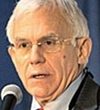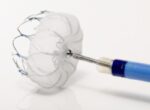Closing off the left appendage as an add-on procedure while performing other cardiac surgery in patients with atrial fibrillation resulted in a reduction in risk of embolic stroke of nearly 40% over 12 months, according to an analysis carried out on the Society of Thoracic Surgeons (STS) database. Patients who had surgical appendage occlusion had<a href="https://solaci.org/en/2017/04/11/closing-off-the-appendage-while-performing-cardiac-surgery-results-in-a-reduction-in-risk-of-embolic-stroke/" title="Read more" >...</a>
LAA Closure: Preventing Stroke in Patients with Atrial Fibrillation and Prior Intracerebral Hemorrhage
Original Title: LAA occlusion vs. standard care in patients with atrial fibrillation and intracerebral hemorrhage – A propensity score matched follow-up study. Presenter: Jens Erik Nielsen-Kudsk Patients with atrial fibrillation and a history of intracerebral hemorrhage, have an elevated risk of both ischemic and hemorrhagic stroke. There is no consensus on how to treat<a href="https://solaci.org/en/2016/05/20/laa-closure-preventing-stroke-in-patients-with-atrial-fibrillation-and-prior-intracerebral-hemorrhage/" title="Read more" >...</a>
IBERIAN: appendage occlusion registry
The aim of this study was to observe the rate of thromboembolic and hemorrhagic events in a period of 2 years in 167 patients undergoing appendage occlusion with Amplatzer device. Appendage occlusion in patients with contraindication to anticoagulation is a safe technique associated with less embolic and bleeding events than expected according to the risk<a href="https://solaci.org/en/2015/06/24/congress-item-8001/" title="Read more" >...</a>
PREVAIL: LAA occlusion versus anticoagulation with warfarin to prevent stroke in patients with non-valvular atrial fibrillation.
An hour before the presentation of the PREVAIL study, the ACC announced the cancellation of the release of the study results. Due to an error in the email system, results of the study were reported a few hours before his presentation. The ACC in an unprecedented decision cancelled the presentation of the study as well<a href="https://solaci.org/en/2015/06/24/congress-item-6699/" title="Read more" >...</a>
Coherex Wave Crest: New device for atrial appendage closure
Appendage closure devices have emerged as an alternative to anticoagulation in fibrillated patients with a contraindication for it. The study included 63 patients with paroxysmal, persistent or permanent FA coupled with a CHADS score >1 and eligible to interrupt anticoagulation. The primary endpoint was atrial appendage occlusion evaluated by ultrasound between 45 and 180 days<a href="https://solaci.org/en/2015/06/24/congress-item-6622/" title="Read more" >...</a>
Percutaneous Left Atrial Appendage Suture: more options in atrial fibrillation patients with antiguagulation contraindication
Original title: Percutaneous Left Atrial Appendage Suture Ligation Using the Lariat Device In Patines UIT Atrial Fibrillation Reference: Krystof Bartus, et al. J Am Coll Cardiol 2013;62:108–18. Atrial fibrillation (AF) is the most frequent arrhythmia and is associated with a 5 fold increase in stroke risk and the resulting morbimortality. Warfarin anticoagulation therapy can be effective but only<a href="https://solaci.org/en/2013/07/18/n-3438/" title="Read more" >...</a>
Appendage trans-catheter closure is equivalent to anticoagulation in fibrillated patients.
Original title: Percutaneous Left Atrial Appendage Closure for Stroke Prophylaxis in Patients With Atrial Fibrillation: 2.3-Year Follow-up of the PROTECT AF (Watchman Left Atrial Appendage System for Embolic Protection in Patients With Atrial Fibrillation) Trial. Reference: Vivek Y. Reddy et al. Circulation. 2013;127:720-729. Atrial fibrillation is the most common sustained arrhythmia in the world and its importance lies<a href="https://solaci.org/en/2013/03/01/n-2927/" title="Read more" >...</a>
Percutaneous closure of the appendage: results, evidence, team training.
Our editors talked with Dr. Aníbal Damonte Percutaneous closure of left atrial appendage is now a practice that is becoming more topical with a view to results and perspectives. In this regard, we interviewed Dr. Aníbal Damonte, interventional cardiologist at the Cardiovascular Institute of Rosario (Rosario, Argentina). WEB SOLACI: May I first ask you to<a href="https://solaci.org/en/2012/09/01/n-3977/" title="Read more" >...</a>
Sub-Analysis of the REVIVED-BCIS2: Myocardial Viability Changes Prognosis in Ischemic Cardiomyopathy Revascularization?
The purpose of myocardial viability testing is to identify patients that might benefit from revascularization by diagnosing three types of myocardium: normal, viable or hibernating, and scarred (non-viable). Non-randomized studies have shown recovery of a viable ventricle after myocardial revascularization surgery (CABG) and improved survival. However, a sub-analysis of the main study on viability testing,<a href="https://solaci.org/en/2024/02/10/sub-analysis-of-the-revived-bcis2-myocardial-viability-changes-prognosis-in-ischemic-cardiomyopathy-revascularization/" title="Read more" >...</a>
Preparation Before Elective Coronary Angiography: Is Prolonged Fasting the Only Option?
When scheduling a coronary angiography, patients are usually instructed to fast for at least 8 hours (no oral intake after dinner). However, this strategy can lead to negative effects such as discomfort, irritability, dehydration, and even hypoglycemia in some cases. Previous studies have not shown significant differences in gastric complications between patients fasting only 2 hours before<a href="https://solaci.org/en/2024/02/09/preparation-before-elective-coronary-angiography-is-prolonged-fasting-the-only-option/" title="Read more" >...</a>








